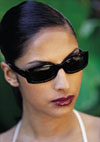|
 Polarized lenses are important for people who work outdoors and require precise vision with minimal glare. They are unique lenses that work much like a Venetian blind. A window blind only lets in light at certain angles which is the way a polarized lens works. Objects become more distinct when the sun's glare is removed and are seen in their true colors. Polarized lens are also a favorite for water sports, fishing, cycling and driving because the reduced glare off water, pavement, snow, and other objects. Polarized lenses are important for people who work outdoors and require precise vision with minimal glare. They are unique lenses that work much like a Venetian blind. A window blind only lets in light at certain angles which is the way a polarized lens works. Objects become more distinct when the sun's glare is removed and are seen in their true colors. Polarized lens are also a favorite for water sports, fishing, cycling and driving because the reduced glare off water, pavement, snow, and other objects.
- Density of color can be dark (C) or light (A).
- The density of color remains constant.
- Materials used include glass, plastic, and polycarbonate.
- Styles include single vision, bifocal and progressive lenses.
- A variety of colors are available: examples, gray, brown, amber.
- Polarized glasses decrease driving fatigue due to much of the glare being reduced from from large areas of pavement.
- Polarized lenses provide comfort around sand and water such as at a beach. Sand and water are both sources of polarized glare which makes this type of lens especially appropriate. Reflected polarized light produces a veiling glare that may cause colors to appear less vivid. With the polarized lenses, colors are not bleached out. Use of polarized lenses is important on bright snowy days. Snow is highly reflective and polarizing. Persons working or driving in the snow benefit from using polarizing lenses. (NOTE: polarizing lenses might not be as advantageous for skiers as one might think. As skier's heads tilt left and right, the polarizing filter becomes less effective as the frame is no longer oriented parallel to the ground).
- Polarized lenses may also react adversely with liquid crystal displays (LCDs) found on the dashboards of some cars or in other places such as digital screens on automatic teller machines.
- When viewed through polarized lenses from certain angles, they can become invisible.
- For outdoor use in conditions with a great amount of glare, polarized lenses can provide many benefits
FREQUENTLY ASKED QUESTIONS ABOUT POLARIZED GLASSES
- What is the difference between a polarized lens and a tinted lens?
While ordinary tinted lenses reduce brightness, only polarized lenses eliminate glare. Polarization is accomplished by placing a thin sheet of polarized film between two layers of material
- What is the difference between a polarized lens and a tinted lens?
While ordinary tinted lenses reduce brightness, only polarized lenses eliminate glare. Polarization is accomplished by placing a thin sheet of polarized film between two layers of material
- How does a polarized lens work?
Light rays vibrate in many different directions. As light passes through a polarized lens, the polarized film channels the light rays to travel in the same direction, thus, eliminating glare much as a Venetian Blind channels light.
- Is it possible to get a clear polarized lens?
It is not possible for a polarized lens to be clear. The amount of polarization a lens achieves is in proportion to the density of the film. The lighter the film, the less polarization that the lens can offer. Tinting a light polarized lens does not increase its polarity - it simply darkens the lens and reduces brightness. Maximum polarization is achieved with a lens that utilizes a dark (grey-c or brown-c) film.
- How thin can polarized lenses be surfaced?
The following are recommended center thicknesses:
- Normal cr-39tm polarized lenses - 1.8mm
- Hi index polarized lenses - 1.7mm
- Polarized polycarbonate lenses - 1.5mm
- Glass polarized lenses - 3.0mm to 3.5mm.
(Glass lenses require additional center thickness to accommodate the front wafer and segment thickness.)
- What determines a superior quality polarized lens?
The three most important factors in determining the grading of a polarized lens are:
- Clarity of the polarized film - inferior polarized lenses have a hazy film. D
- ensity of the polarized film - lenses that possess a light film do not perform as well as lenses that utilize a dark film.
- Film placement - in order to produce a cosmetically appealing thin pair of polarized glasses, the laboratory must be able to precisely know where the polarized film is placed in relation to the front of the lens.
- Can polarized lenses be tinted and is this recommended?
Yes, polarized lenses may be tinted. It is recommended that a tinting temperature be of 200 degrees or less. Tinting is available for people trying to achieve a particular color but does not increase polarization.
- Do polarized lenses provide UV protection?
Yes, the polarized lenses that Texas America Safety Company carries afford 99% absorption at 380 nanometers.
- Can polarized lenses be AR coated (anti-reflection coating)?
Yes, AR coating is available; however, it is unnecessary to AR coat both sides. It is normally recommended coating only the back side curve.
- Are polarized lenses available with a photochromic material?
Yes, there is a lens available called Transhades that is both a polarized and a photochromic lens.
|